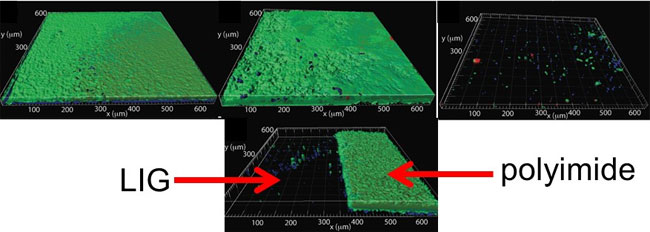Laser-induced graphene (LIG) has been shown to be effective in resisting biofouling (the buildup of biological material on wet surfaces) and, when used as electrodes with a small applied voltage, in destroying bacteria.
“This form of graphene is extremely resistant to biofilm formation, which has promise for places like water-treatment plants, oil-drilling operations, hospitals and ocean applications like underwater pipes that are sensitive to fouling,” James Tour, Rice University chemist and developer of LIG, said. “The antibacterial qualities when electricity is applied is a great additional benefit.”

In the top row, the growth of biofilm on surfaces with a solution containing Pseudomonas aeruginosa is observed on, from left, polyimide, graphite and laser-induced graphene surfaces. Green, red and blue represent live bacteria, dead bacteria and extracellular polymeric substances, respectively. At bottom, a sheet of polyimide burned on the left to leave laser-induced graphene shows the graphene surface nearly free of growth. Courtesy of Arnusch Lab/Ben-Gurion University of the Negev.
LIG was printed on a polyimide film by irradiation with a CO2 IR laser under ambient conditions. Researchers investigated the antibacterial activity of the LIG surface using LIG powder in suspension or deposited on surfaces. The antimicrobial effects of the LIG surface were greatly amplified when voltages in the range of 1.1 to 2.5 V were applied in an electrode configuration in bacterial solutions. The bactericidal mechanism was observed using microscopy and fast photography, which showed a rapid bacterial movement toward the LIG surface and subsequent bacterial killing.
Electrochemical generation of hydrogen peroxide was observed; however, the bacterial killing mechanism depended strongly on the physical and electrical contact of the bacterial cells with the surfaces. When LIG electrodes were tested in a bacteria-laden solution with 10 percent secondary treated wastewater, bacteria in a solution with LIG electrodes above 1.1 volts were drawn toward the anode. Above 1.5 volts, the bacteria began to disappear and vanished completely within 30 seconds. After nine hours at 2.5 volts, 99.9 percent of the bacteria were killed after one second and the electrodes strongly resisted biofilm formation.
LIG’s anti-fouling properties keep dead bacteria from accumulating on the surface, Tour said.
Researchers surmise that bacteria are destroyed by a combination of contact with the rough surface of LIG, electrical charge, and toxicity from localized production of hydrogen peroxide.
The antibiofilm activity of the LIG surfaces and electrodes could lead to efficient protection of surfaces that are susceptible to biofouling in environmental applications.
“The combination of passive biofouling inhibition and active voltage-induced microbial removal will likely make this a highly sought-after material for inhibiting the growth of troublesome natural fouling that plagues many industries,” said Tour.
Researchers at Rice University and at Ben-Gurion University of the Negev (BGU) partnered to conduct the research.
The research was published in Applied Materials & Interfaces (doi: 10.1021/acsami.7b04863).
Pseudomonas aeruginosa bacteria tagged with green fluorescent protein, which appear as bright dots, are drawn to an anode of laser-induced graphene, where they die. The anode at the top, which is separated from a cathode by a 100-micron channel, carries a small voltage that boosts its antibacterial properties. Courtesy of the Arnusch Lab/BGU.